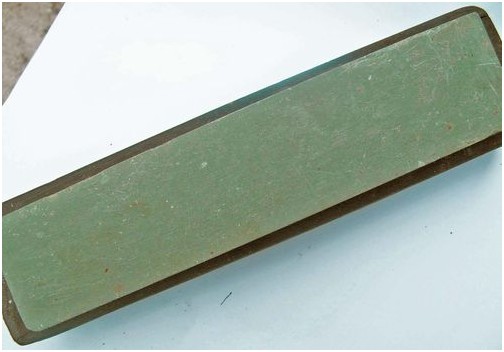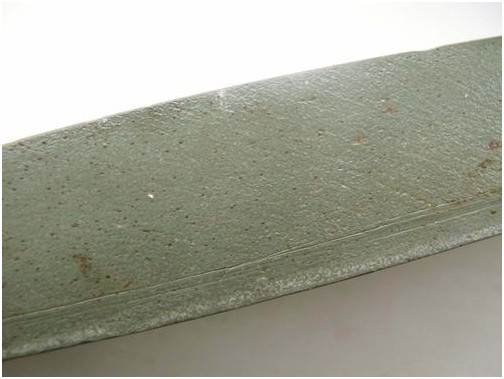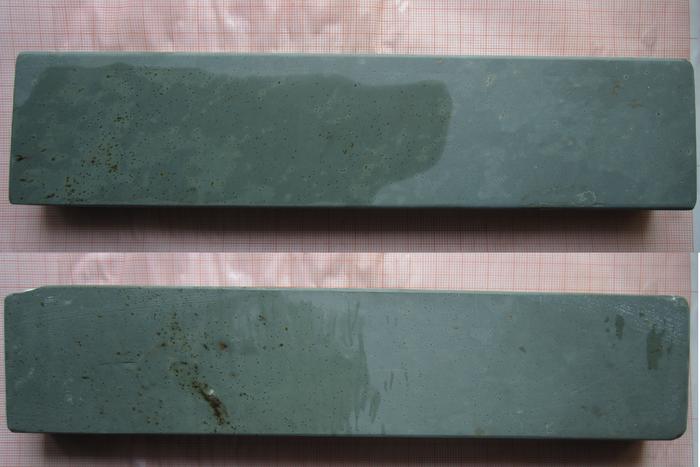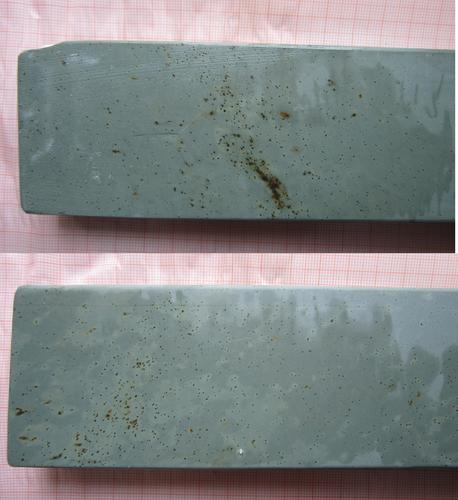Results 1 to 10 of 29
Thread: Mint green hone with orange dots
-
09-05-2012, 10:47 AM #1
 Mint green hone with orange dots
Mint green hone with orange dots
I recently purchased this hone on the bay from a GB vendor. It came in a typical wood storage, but hasnít been used with oil in the past.
Itís a hard hone, maybe novaculite, so it could be a CF or LI. But I have not seen a hone in this mint color stained with lighter colored patches and with orange and dark/black dots.




Any idea what it is?
-
09-05-2012, 12:37 PM #2

I don't know, however, I recently got one myself - very pretty.
I haven't had much time to play with it yet, though.
It was advertised as a CambrianHang on and enjoy the ride...
-
09-05-2012, 12:42 PM #3Historically Inquisitive



- Join Date
- Aug 2011
- Location
- Upstate New York
- Posts
- 5,782
- Blog Entries
- 1
Thanked: 4249
Well looking at the first pic looks very green color, the others pics looks more like blue grey and the wet areas a little on the green side. Looking at pic #3 i would say its a Lynn Idwall, the apparent flaking is very typical to LI. Does it produce a milky white slurry? Perhaps a pic of the chipped end would help the identification of this stone? Would you say that its a finisher?
-
09-05-2012, 12:57 PM #4

I'd say it was a LI. Remember they are not all the same. I've had a similar one to that with orange dots. Why don't you test it?
-
09-05-2012, 03:29 PM #5Senior Member


- Join Date
- Jul 2011
- Posts
- 2,110
Thanked: 459
It must be a cutler's green hone!
(i pondered ordering one of those but the shipping cost from AJ is just too high to play around with unverified stones once you already have enough other unverified hones. I wish he would ship economy with no tracking for repeat customers who are not a threat requiring signature confirmation)
-
09-05-2012, 03:56 PM #6Historically Inquisitive



- Join Date
- Aug 2011
- Location
- Upstate New York
- Posts
- 5,782
- Blog Entries
- 1
Thanked: 4249
-
09-05-2012, 04:13 PM #7

I had not much time to try it in detail right now. Slurry is light milky mint green. Stone is as hard as some of my LI due to my opinion but takes more material than a LI during honing.
From the grit and honing capability I would rate it between a TOS and a LI. This would also fit for a mixture of both concerning the look. Green color from the LI, dots from the TOS. But it ain't that easy!
By the way, this is not the stone AJ sells as possible cutlers green. I got one of these too and the stones are totally different.Last edited by hatzicho; 09-05-2012 at 04:47 PM.
-
The Following User Says Thank You to hatzicho For This Useful Post:
Havachat45 (09-10-2012)
-
09-19-2012, 04:38 PM #8Senior Member



- Join Date
- Apr 2008
- Location
- Essex, UK
- Posts
- 3,816
Thanked: 3164
I have a similar hone, very old, set on a wooden paddle with a handle - probably dates to the last half of the 1800s. It is quite thin - about 8mm thick - and although it looks and feels hard and glassy it scores fairly easily and is not 'vitreous' like you would associate with some novaculites. It is a decent finisher (but too 'keen' an edge for me - I find the shave slightly uncomfortable) and I would put it conservatively as equivalent to a 10k hone.
It has small black dots, larger orange areas and the matrix is a fresh, minty green. If looked at under magnification some of the orange areas have a darker brown core which looks like rust, so there is iron oxide in it. I would think that the lighter orange colour is staining spreading from the iron oxide nucleus. Where dark spots (not the brown iron oxide spots) occur in the middle of an orange area they seem to 'repel' the orange stain, leaving a halo of the mint green stone.
There is some flaking, but it does not exhibit the conchoidal fractures we usually see in Llyn Idwals, and which are familiar to anyone who has seen knapped flints. Flint, BTW is a form of chert, as is novaculite. Although our uses are mainly to do with the microporous, micro- or cryptocrystalline forms of silicon-rich chert, there are many types. It can range from very hard to very soft - some types are like chalk, and where it is formed in beds it can take on a surprising range of colours from sediments and layers that form next to and along with it - for instance there is a beddded form that consists of alternate bands of chert and shale.
My paddle would seem to be a form of chert or novaculite (sometimes referred to as metachert) that is softer than LI and the hard Arkansas hones, with impurities such as iron oxide (or posibly manganese, which can also give a rusty red/brown colour) that have given it the brown/orange splodges. I don't know what other trace elements have contributed to the little dark spots and the main matrix of the stone, but curiously enough iron can give rise to both orange/brown and green colouring, according to whether it is ferrous (reduced, green) or ferric (oxidized, brown).
In short - yet another mystery hone.
Regards,
Neil
-
The Following User Says Thank You to Neil Miller For This Useful Post:
hatzicho (09-19-2012)
-
09-19-2012, 06:01 PM #9Historically Inquisitive



- Join Date
- Aug 2011
- Location
- Upstate New York
- Posts
- 5,782
- Blog Entries
- 1
Thanked: 4249
No pics Neil really?
-
09-19-2012, 06:43 PM #10


 18Likes
18Likes LinkBack URL
LinkBack URL About LinkBacks
About LinkBacks






 Reply With Quote
Reply With Quote





